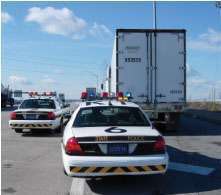2009 traffic fatality rate hits record low
Factors include ad campaigns, less driving
 The National Highway Traffic Safety Administration attributes the decline in traffic fatalities in 2009 to a combination of factors that include high-visibility enforcement campaigns.
The National Highway Traffic Safety Administration attributes the decline in traffic fatalities in 2009 to a combination of factors that include high-visibility enforcement campaigns.The U.S. Department of Transportation announced that the number of overall traffic fatalities reported at the end of 2009 reached the lowest level since 1954, declining for the 15th consecutive quarter. According to early projections, the fatality rate, which takes into account the number of miles traveled, reached the lowest level ever recorded.
“This is exciting news, but there are still far too many people dying in traffic accidents,” says U.S. Transportation Secretary Ray LaHood. “Drivers need to keep their hands on the steering wheel and their focus on the road in order to stay safe.”
The projected fatality data for 2009 places the highway death count at 33,963, a drop of 8.9 percent as compared to the 37,261 deaths reported in 2008. The fatality rate for 2009 declined to the lowest on record, to 1.16 fatalities per 100 million Vehicle Miles Traveled (VMT), down from 1.25 fatalities per 100 million VMT in 2008.
The National Highway Traffic Safety Administration attributes the decline in 2009 to a combination of factors that include high-visibility enforcement campaigns like “Click It or Ticket” to increase seatbelt use and “Drunk Driving. Over the Limit. Under Arrest,” which helps with the enforcement of state laws to prevent drunk driving and distracted driving. In addition, the decline is also the result of safer roads, safer vehicles and motorists driving less.
“This continuing decline in highway deaths is encouraging, but our work is far from over,” says NHTSA Administrator David Strickland. “We want to see those numbers drop further. We will not stop as long as there are still lives lost on our nation’s highways. We must continue our efforts to ensure seatbelts are always used and stay focused on reducing distracted and impaired driving.”
NHTSA annually collects crash statistics from the 50 states, the District of Columbia and Puerto Rico to produce annual reports on traffic fatality trends. The agency intends to update 2009 estimates regularly as more data becomes available. The final counts for 2009 will be made available in the summer of 2010. To view the preliminary fatality statistics, go to www-nrd.nhtsa.dot.gov/Pubs/811291.PDF.
In brief
* The American Trucking Associations encouraged Congress to pass “Jason’s Law” that would allow the U.S. Department of Transportation – in cooperation with appropriate state, regional and local governments – to allocate funds for new rest areas and the expansion and improvement of existing rest areas.
* Iowa became the 21st state to ban texting when Gov. Chet Culver signed an anti-texting-while-driving bill into law for all drivers. The new law also prohibits teens with intermediate or restricted licenses from using cell phones at all.
* Washington State made talking or texting on a cell phone without a hands-free device a primary offense. The new law signed by Gov. Christine Gregoire strengthens Washington’s 2008 ban that allowed law enforcement officials to ticket drivers caught using their phones if they were pulled over for another offense.
* The Federal Motor Carrier Safety Administration granted a limited 90-day waiver from federal hours-of-service regulations for the transportation of anhydrous ammonia within a 100 air-mile radius of the retail or wholesale distribution point. For more information, go to www.regulations.gov and search FR Doc. 2010-6244.
* Labelmaster’s 84-page 2010 Label Source Catalog contains hundreds of labeling products, including shipping, hazard class, regulated, government-required and warehouse. To receive a free catalog, go to www.labelmaster.com.













